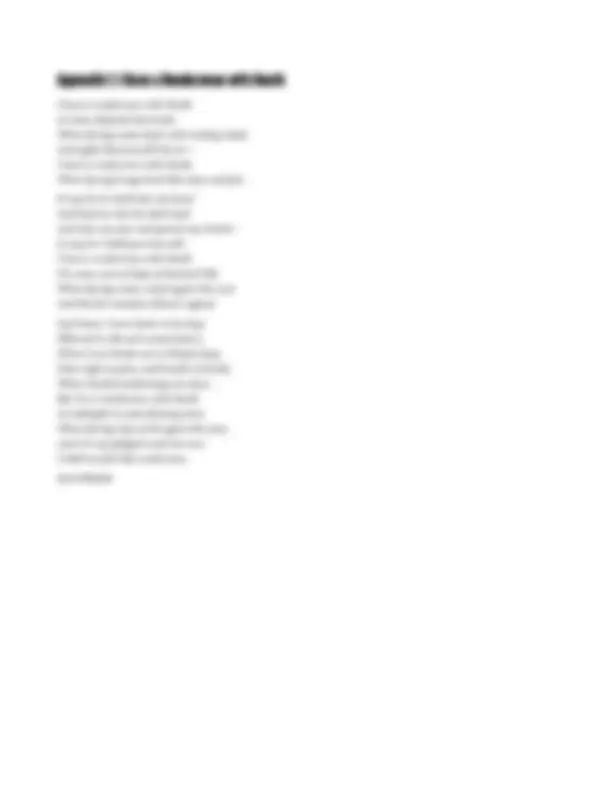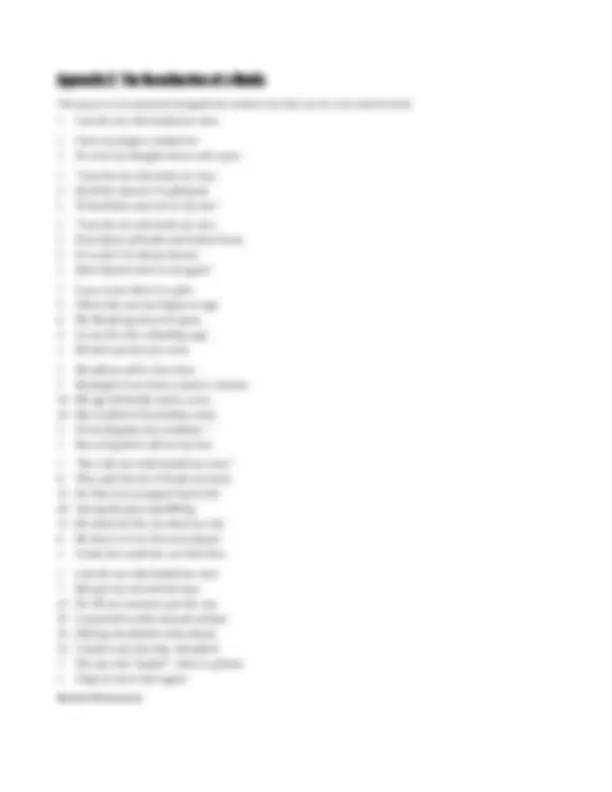




Study with the several resources on Docsity

Earn points by helping other students or get them with a premium plan


Prepare for your exams
Study with the several resources on Docsity

Earn points to download
Earn points by helping other students or get them with a premium plan
Community
Ask the community for help and clear up your study doubts
Discover the best universities in your country according to Docsity users
Free resources
Download our free guides on studying techniques, anxiety management strategies, and thesis advice from Docsity tutors
The author's attempt to write a war poem in the style of alan seeger's 'rendezvous with death'. The essay analyzes the rhyme scheme, meter, and use of metaphors and personifications in seeger's poem and the author's own attempt. The document also explores the themes of helplessness and survival in war poetry.
Typology: Lecture notes
1 / 4

This page cannot be seen from the preview
Don't miss anything!



The best writing often arises from the worst situations. War poetry has been, not so happily, a staple of poetry, especially during World War I, and even after the war had ended, the messages they deliver burn into our hearts. But is it possible for me, a teen born postbellum, to replicate the effect that the poets who went through the war themselves? I have attempted just that, and while I don’t believe I can ever hope to reach the profundity of the real war poetry, I have succeeding in passing off as one. The poem I analyzed was I Have a Rendezvous with Death written by Alan Seeger. A copy of this, and my own poem, are attached at the end of this essay. In Rendezvous, there are three stanzas six, eight, and ten lines long respectively, and they have the complex rhyme scheme ABBCAC DDAEAEFF GHGAFAHFAA, a rhyme scheme that I have never heard before, but is oddly orderly. Each line is an iambic tetrameter, and one line, “I have a rendezvous with Death”, is repeated throughout the poem. Therefore, in my own creation, I de- cided to up the orderliness by using Pascal’s Triangle as a motif. If you are not familiar with Pascal’s Triangle, it is a triangle of numbers where each number is the sum of the two numbers above it, starting with a single 1. It is mathematically iconic not only in that it is relevant in wide areas from polynomial algebra to statistics, nor only that it yields countless mathematically useful patterns, but also for its beauty when visualized in certain ways, most notably highlighting multiples of a certain number. I made each stanza correspond with a row of Pascal’s Triangle, corresponding each number with a rhyming ending. I also used the sentence “I am the one who healed our men” or some variant of that as a refrain repeated about every other stanza. And more basically, I used the same meter as Rendezvous. However, the part where I failed to reproduce as the flowery, vivid imagery observable in Rendezvous exe- cuted using metaphors, personifications, and repetition. Repetition I mentioned earlier, and it is stated repeatedly to set the scene and keep the topic in the reader’s mind. Metaphors include “his [Death’s] dark land”, likely refer - ring to the afterlife or the process of death, “It may be I shall pass him still”, hoping for a peaceful and painless death, and “Where Love throbs out in blissful sleep”, in reference to life “draining out” from a dead body. Personi- fications, specifically, are seen more often than the other kinds of metaphors; as in the refrain, death is personi - fied as someone the narrator has “a rendezvous with”, and someone who “take[s the narrator’s] hand / And lead[s the narrator] into his dark land”, and so is spring, depicted as something that “comes back with rustling shade” and “brings back blue days and fair”. It is a given that poetry should contain comparisons and vivid imagery, and metaphors including personifications are the principal way in which this can be achieved. However, the rigid form of my poem made me neglect using vivid imagery, instead settling on banalities.
Pascal’s Triangle, up to Row 6.
While the themes of our two poems differ, they stem from the same thought. The theme of Rendezvous I observed to be the idea that while humans are fighting wars and losing lives, Spring comes every year regardless, bringing new life into the world, and despite the coldness of reality and the disinterest of nature upon human af- fairs, the narrator is determined to survive. However, the theme of my poem I intended to be: While humans are fighting wars and losing lives, the narrator always thought he was saving lives by being a medic. But after he met the terminally injured young soldier, he is ashamed of his own ineptness and doubts if he should have survived. Though the conclusions of the two themes are different, they both derive from helplessness to stop the horrific acts of war. As a conclusion, while I had fun attempting to write a structured and message-heavy work of literature, I gained a newfound respect to the poets who also fought in the war and survived to tell their tale to us. I could never approach how deep the works resonate within our hearts, though trying to do so was—I dare say—an en- tertaining experience.
This poem is to be presented alongside the numbers, but they are not to be read out loud. 1 I am the one who healed our men. 1 I have my fingers, totaled ten 1 To write my thoughts down with a pen. 1 “I am the one who heals our men. 2 Of all the injuries I've glimpsed, 1 To heal them most are in my ken.” 1 “I am the one who heals our men 3 From blasts of bombs and broken bones. 3 It is a fact I've always known: 1 More injured come to me again.” 1 I saw a man down in a glen 4 Where this war just began to rage. 6 His bloody leg was torn apart, 4 As was his ribs, a bleeding cage. 1 He had a picture of a wren. 1 He told me of his vista when 5 He fought in our home country's mission. 10 His age did hardly reach a score, 10 But excelled in his frontline corps. 5 I'd not forgotten his condition— 1 But curing him’s still out my ken. 1 “He is the one who’s healed our men,” 6 They said, but oh, it breaks my heart. 15 For that wise youngster had to die 20 Among this gory squabbling. 15 He asked me this, he asked me why 6 He shan't survive but must depart. 1 I tried, but could not cure him then. 1 I am the one who healed our men 7 But quit my uninvolvèd ways. 21 For till our countries quit the war, 35 I stayed alive while mounds of dead 35 Piled up the field for miles ahead. 21 I made it out, but why, wherefore? 7 The one who “healed”—that is a phrase 1 I hope to never hear again. HARUKI WAKAMATSU